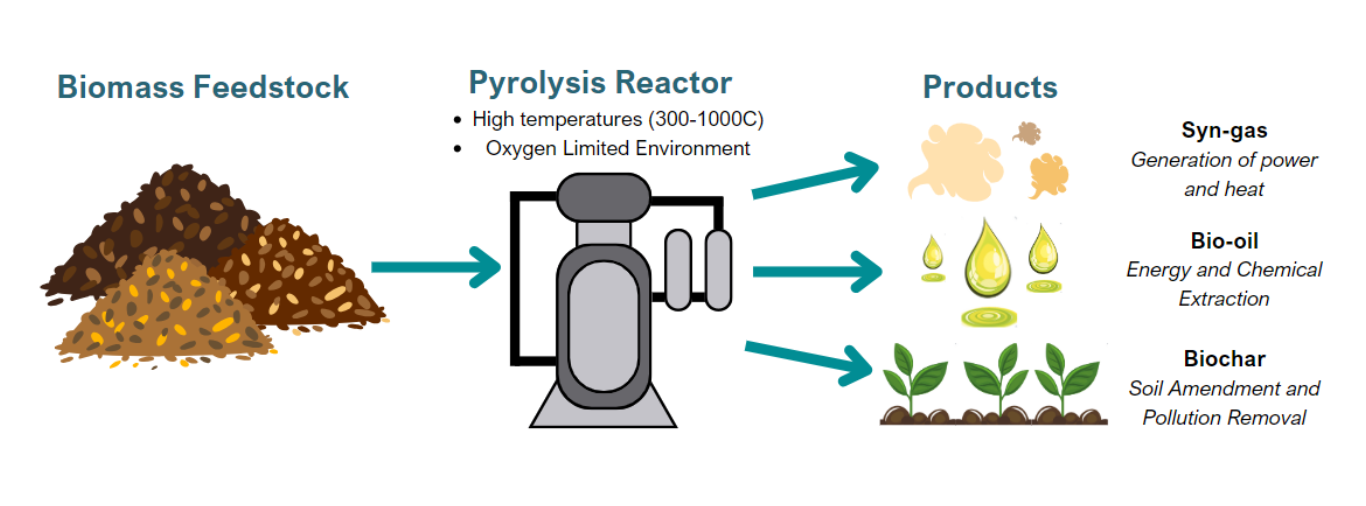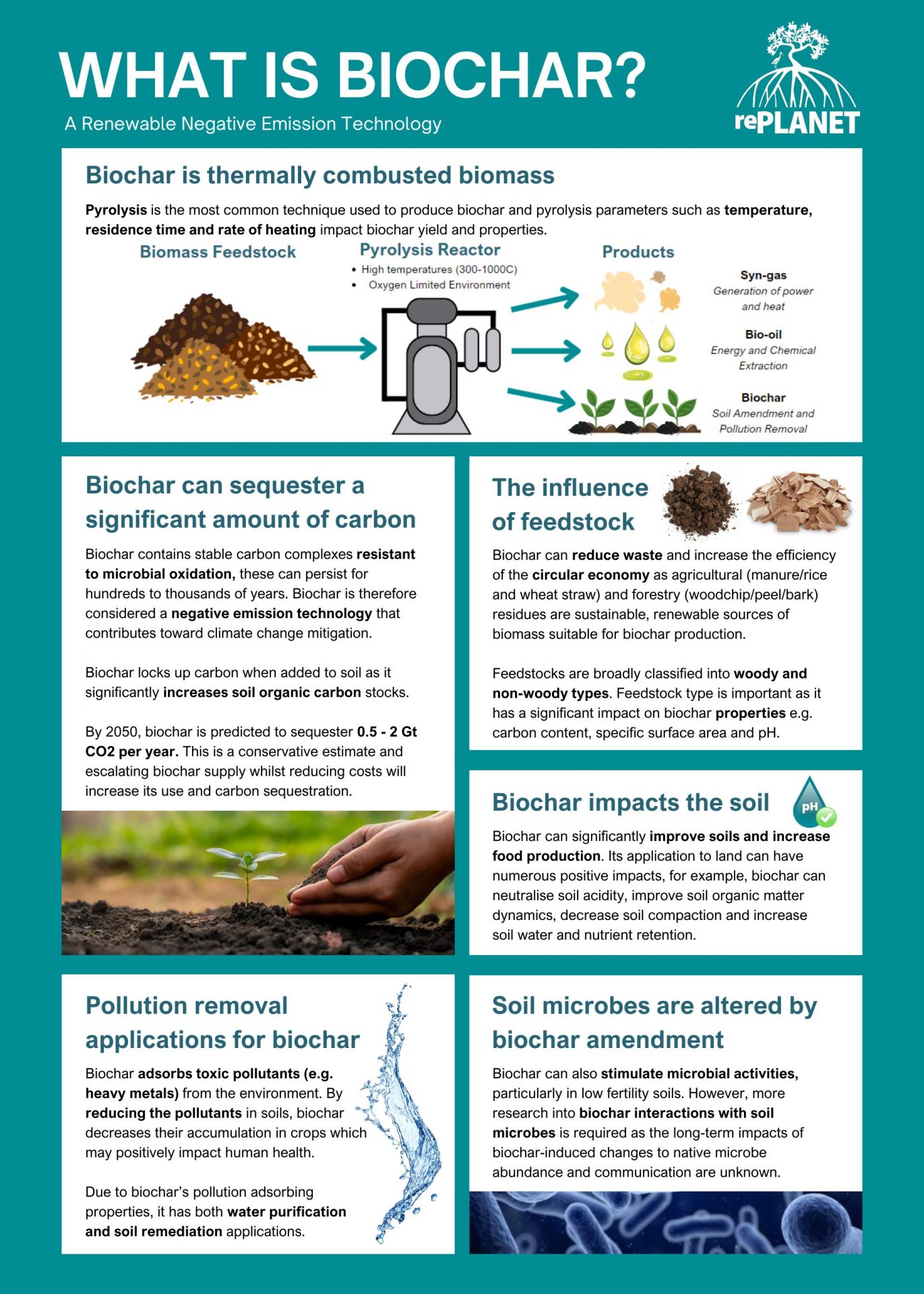24 January 2024 by Georgie Tugwell
Biochar has emerged in recent years as a versatile negative emission technology (NET), capturing the attention of scientists, policymakers, and NGOs alike. Historically, biochar has been utilized by indigenous communities in the Amazon to enhance poor, acidic soils, however, it can now be produced on industrial scales with potential applications ranging from climate change mitigation to sustainable agriculture, construction, and bioenergy generation. Recent enthusiasm for biochar is fuelled by its cost-effectiveness, multi-functionality and ease of preparation; its large specific surface area, high porosity, and stability are just a few biochar properties that enable it to adsorb pollutants, mitigate greenhouse gas (GHG) emissions, remediate wastewater, etc.
How is Biochar Produced?
Biochar is derived from biomass that has been thermally combusted at high temperatures in oxygen-limited environments. Several thermochemical techniques can be used for biochar synthesis, with the most common being pyrolysis. Biochar synthesis by-products include bio-oils and syn-gases which can be recycled to increase pyrolysis efficiency or used for other applications such as bioenergy, figure 1.

Figure 1: Biochar Production. Pyrolysis of biomass feedstocks at high temperatures in oxygen limited environments yields biochar along with syn-gases and bio-oils.
Feedstock type (meaning the type of biomass used e.g. crop residues, manure, wood) and pyrolysis parameters such as temperature, residence time and rate of heating significantly impact the physiochemical properties of biochar. For example, the carbon content of biochar produced at 750°C is typically higher than in biochar produced at 500°C. In addition, the use of wood feedstock over manure creates biochar with higher carbon content and lower nitrogen. Woody and non-woody biomass form the two principal feedstock types used for biochar synthesis, with wood-derived biochar demonstrating superior properties for soil amendment and carbon sequestration.
Potential Advantages to Biochar-based Solutions
A Circular Economy: Biochar’s popularity stems from its ability to utilize agricultural and forestry waste, contributing to the efficiency of the circular economy. With careful optimization of feedstock, production processes, and regular laboratory analysis, biochar becomes an excellent method for repurposing waste agricultural and forestry residues. It not only improves soils and increases crop yields but also serves as an effective and renewable carbon sequestration strategy.
Biochar Carbon Sequestration: If applied at a global scale, biochar is conservatively estimated to sequester 0.5 – 2 GtCO2 each year by 2050. Carbon in biochar (~97%) is recalcitrant, meaning it is very stable and will persist in soils for hundreds to thousands of years. Higher pyrolysis temperatures tend to generate larger quantities of biochar stable carbon, and this contributes to long-term soil carbon sequestration. Non-CO2 emissions from soils can are also reduced by biochar, for example, applying biochar to soils has been proven to significantly decrease N20 emissions.
Biochar Impacts on Soil Quality: Biochar improves soil physicochemical properties, such as pH, nutrient retention, water retention, aeration, drainage, organic carbon stocks, dynamics. Biochar soil fertility enhancements have been reported to increase crop yields, agroecosystem resilience, and greater food security. Biochar-mediated pollution removal also improves soils, its large specific surface area and functional groups efficiently adsorb toxic pollutants such as heavy metals and organic contaminants from the environment, and it therefore has soil and water remediation applications.
Potential Disadvantages to Biochar-based Solutions
Biochar Causing Pollution: While biochar offers numerous benefits, concerns exist regarding its potential contamination with substances such as polycyclic aromatic hydrocarbons (PAHs) and heavy metals. Careful consideration of feedstock and pre-treatment processes can mitigate biochar mediated contamination of soils and associated human and environmental health risks.
Biochar Impacts Native Soil Biota: Amendment to soils has been reported to alter compositions of native soil microbes, potentially increasing pathogenic microbes while decreasing beneficial soil biota. Whilst strong toxic effects of biochar have not been found, its impact on soil microbes, mycorrhizal fungi, earthworms, and microbial communication requires further research and understanding.
Reversibility Risks: Reversibility risks arise if biochar is eroded from the soil surface e.g. by wind and rain. Application to soil subsurface and mixing biochar with other amendments e.g. compost is recommended to mitigate erosion risks that would reduce the carbon sequestration of the biochar.
Biochar-based solutions in Action
Standards, Certifications and Methodologies: The International Biochar Initiative (IBI) and the European Biochar Certificate (EBC) have published biochar standards and certifications to promote universal biochar safety and quality. Verra has also published a biochar methodology, and the Climate Action Reserve (CAR) is developing a U.S. and Canada Biochar Protocol, thereby enabling the quantification and verification of biochar carbon credits. These standards aim to establish consistent definitions, testing guidelines, and reporting requirements for Biochar-based solutions.
Producers and Projects: Several initiatives worldwide showcase the diverse applications of biochar. In Costa Rica, SeaChar’s biochar cookstoves have not only improve air and soil quality but also provide an additional income stream to households through a biochar buyback program. Globally, companies like ARTi, Rogue Biochar, Emergent Waste Solutions, HaiQi and Novocarbo are leading the way in industrial-scale biochar synthesis, exploring applications in agriculture, water treatment, and construction.
Final Thoughts
Biochar is a versatile NET that can aid in addressing numerous environmental, social, and economic challenges. While there are concerns and challenges to overcome, ongoing research and adherence to standards and certifications will contribute to unlocking the extensive range of benefits that biochar-based solutions offer. As the world seeks sustainable solutions, biochar stands out as a promising ally in the journey towards a greener and more resilient future.
Biochar Summary Poster:
